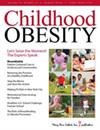Protective Eating Behaviors Among Children at Higher Risk for Obesity in the INSIGHT Study.
IF 1.5
4区 医学
Q2 PEDIATRICS
引用次数: 0
Abstract
Background: Maternal pre-pregnancy body mass index (BMI) is positively associated with offspring overweight. We investigated behaviors that may confer resilience to childhood overweight development by examining appetitive traits in at-risk children born to mothers with pre-pregnancy overweight. Methods: This secondary analysis included children born to mothers with pre-pregnancy BMI ≥25 kg/m2 from the Intervention Nurses Start Infants Growing on Health Trajectories Study (N = 84). Mothers completed the Child Eating Behavior Questionnaire (CEBQ) at child ages 30 months and 6 years. t-tests assessed differences in appetitive traits (CEBQ subscale scores) between children with overweight (BMI ≥85th percentile) and without overweight (BMI <85th percentile). Results: The 87 children (41 female [47%]) included in this analysis were predominantly White and non-Hispanic (93%), and 34 (39%) had overweight at age 6 years. Compared with children with overweight, children without overweight had mothers who reported greater child slowness in eating when their child was 30 months (p = 0.04) and 6 years old (p = 0.004). Similarly, mothers of children without overweight reported higher child satiety responsiveness, lower enjoyment of food, and lower food responsiveness (p < 0.001 for all) when their child was 6 years old. Conclusion: Eating slower, higher satiety responsiveness, lower enjoyment of food, and lower food responsiveness were protective factors against developing overweight among those with familial risk. Strategies to promote the development of slower eating and satiety responsiveness could be explored as part of obesity prevention strategies.INSIGHT 研究中肥胖高风险儿童的保护性饮食行为。
背景:母亲孕前体重指数(BMI)与后代超重呈正相关。我们通过检测孕前超重母亲所生高危儿童的食欲特质,研究了可能对儿童期超重发展产生抗逆性的行为。研究方法这项二次分析包括孕前体重指数(BMI)≥25 kg/m2的母亲所生的儿童,这些儿童来自 "干预护士启动婴儿健康成长轨迹研究"(N = 84)。母亲在孩子30个月大和6岁时填写了儿童饮食行为问卷(CEBQ)。t检验评估了超重儿童(体重指数≥85百分位数)和非超重儿童(体重指数<85百分位数)之间食欲特质(CEBQ分量表得分)的差异。结果:参与分析的 87 名儿童(41 名女性[47%])主要为白人和非西班牙裔(93%),其中 34 名儿童(39%)在 6 岁时超重。与超重儿童相比,未超重儿童的母亲在其子女 30 个月大时(p = 0.04)和 6 岁时(p = 0.004)报告的儿童进食速度更慢。同样,没有超重的儿童的母亲在其子女 6 岁时报告的儿童饱腹感反应能力较高、对食物的喜爱程度较低以及对食物的反应能力较低(均 p < 0.001)。结论进食速度较慢、饱腹感较强、对食物的喜爱程度较低以及对食物的反应能力较低是有家族遗传风险的儿童出现超重的保护因素。作为肥胖预防策略的一部分,可以探索促进进食速度减慢和饱腹感反应能力发展的策略。
本文章由计算机程序翻译,如有差异,请以英文原文为准。
求助全文
约1分钟内获得全文
求助全文
来源期刊

Childhood Obesity
PEDIATRICS-
CiteScore
4.70
自引率
8.00%
发文量
95
期刊介绍:
Childhood Obesity is the only peer-reviewed journal that delivers actionable, real-world obesity prevention and weight management strategies for children and adolescents. Health disparities and cultural sensitivities are addressed, and plans and protocols are recommended to effect change at the family, school, and community level. The Journal also reports on the problem of access to effective healthcare and delivers evidence-based solutions to overcome these barriers.
 求助内容:
求助内容: 应助结果提醒方式:
应助结果提醒方式:


